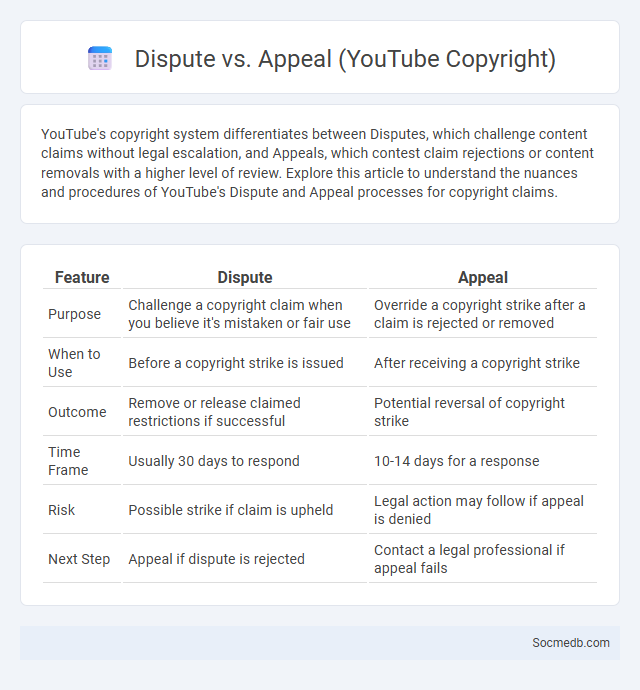
Photo illustration: Dispute vs Appeal (YouTube Copyright)
YouTube's copyright system differentiates between Disputes, which challenge content claims without legal escalation, and Appeals, which contest claim rejections or content removals with a higher level of review. Explore this article to understand the nuances and procedures of YouTube's Dispute and Appeal processes for copyright claims.
Table of Comparison
| Feature | Dispute | Appeal |
|---|---|---|
| Purpose | Challenge a copyright claim when you believe it's mistaken or fair use | Override a copyright strike after a claim is rejected or removed |
| When to Use | Before a copyright strike is issued | After receiving a copyright strike |
| Outcome | Remove or release claimed restrictions if successful | Potential reversal of copyright strike |
| Time Frame | Usually 30 days to respond | 10-14 days for a response |
| Risk | Possible strike if claim is upheld | Legal action may follow if appeal is denied |
| Next Step | Appeal if dispute is rejected | Contact a legal professional if appeal fails |
Understanding YouTube Copyright: Dispute, Appeal, and Strike
Understanding YouTube copyright involves knowing how disputes arise from unauthorized content use and how to effectively submit appeals if you believe a claim is incorrect. YouTube's copyright strike system penalizes repeated violations, risking channel suspension, so managing your claims accurately protects your content and your channel's reputation. Familiarizing yourself with the dispute and appeal processes helps ensure your videos remain compliant and your rights are defended.
What is a Copyright Dispute on YouTube?
A copyright dispute on YouTube occurs when a content creator challenges a claim that their video infringes on someone else's copyrighted material. This process allows creators to contest claims if they believe their content qualifies as fair use, contains original work, or has proper licensing. Resolving these disputes is essential to maintaining the monetization and availability of videos on the platform.
How to Initiate a Copyright Dispute
To initiate a copyright dispute on social media, you need to identify the infringing content and gather evidence proving your ownership or rights. You must submit a detailed copyright complaint through the platform's official reporting system, including specific URLs, a description of the original work, and your contact information. Your prompt and accurate action can help protect your intellectual property and prevent unauthorized use on social networks.
What Happens After Submitting a Dispute?
After submitting a dispute on social media platforms, the content undergoes a review process by the platform's moderation team or automated systems to assess the validity of the claim. The platform typically notifies the user of the dispute outcome, which can result in reinstatement, removal, or further investigation of the content. Response times vary by platform but generally range from a few hours to several days, impacting the visibility and engagement of the disputed content.
YouTube Copyright Appeals Process Explained
The YouTube Copyright Appeals Process allows content creators to contest copyright claims or strikes against their videos by submitting a detailed appeal form specifying the basis of their dispute. This process involves an evaluation by the claimant, who can either release the claim or uphold it, potentially resulting in a copyright strike that affects the creator's channel standing. Understanding YouTube's Copyright Center guidelines and using precise, evidence-backed appeals enhances the likelihood of a successful resolution.
Key Differences Between Dispute and Appeal
Disputes on social media typically involve challenging content decisions, such as removals or restrictions, based on platform policies and community guidelines. Appeals occur when you formally request a higher-level review after an initial dispute decision, seeking to reverse or modify the outcome. Understanding these distinctions helps ensure your content is managed effectively and your rights are protected on platforms like Facebook, Instagram, and Twitter.
What is a Copyright Strike on YouTube?
A Copyright Strike on YouTube occurs when your uploaded content infringes on someone else's copyrighted material, such as videos, music, or images. Receiving a copyright strike can lead to restrictions on your account, including limiting uploads, disabling live streams, or even account termination if multiple strikes accumulate. Protecting your YouTube channel requires understanding copyright policies and ensuring originality or proper permissions for all shared content.
Consequences of Receiving a Copyright Strike
Receiving a copyright strike on social media can significantly impact your account by restricting content uploads and limiting audience reach. Your ability to monetize videos or access platform features may be suspended, potentially leading to account termination if multiple strikes accumulate. Protecting your content from copyright violations ensures your engagement and channel growth remain uninterrupted.
Dispute vs. Appeal vs. Copyright Strike: Comparative Table
Dispute, appeal, and copyright strike represent distinct mechanisms for addressing content conflicts on social media platforms, each with unique processes and consequences. A dispute allows content creators to challenge a claim without legal involvement, often used when fair use or ownership is in question. An appeal is a formal request to review a decision after a dispute is resolved, while a copyright strike indicates a serious violation resulting in penalties such as content removal or account suspension on platforms like YouTube.
Best Practices to Avoid Copyright Issues on YouTube
To avoid copyright issues on YouTube, you should always use original content or obtain explicit permission and licenses for any third-party materials such as music, videos, or images. Utilize YouTube's Content ID system to identify potential copyright claims before publishing and apply fair use principles cautiously by providing commentary, criticism, or education. Properly credit creators when required and regularly review YouTube's copyright policies to keep your channel compliant and protect your content from takedown or demonetization.
 socmedb.com
socmedb.com